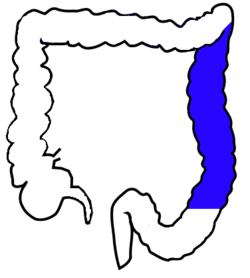Descending colon
| Descending colon | |
|---|---|

Drawing of colon seen from front (descending colon coloured blue)
|
|

|
|
| Details | |
| Precursor | Hindgut |
| System | Digestive system |
| Artery | Left colic artery |
| Identifiers | |
| Latin | Colon descendens |
| MeSH | A03.556.124.526.356.500 |
| TA | A05.7.03.006 |
| FMA | 14547 |
|
Anatomical terminology
[]
|
|
The descending colon is the part of the large intestine from the splenic flexure to the beginning of the sigmoid colon. The function of the descending colon in the digestive system is to store the remains of digested food that will be emptied into the rectum.
The descending colon begins at the splenic flexure at the upper left part of the abdomen. It passes downward through the left hypochondrium and lumbar regions, along the outer border of the left kidney and end at the lower left part of the abdomen where it is continues as the sigmoid colon. It is retroperitoneal in two-thirds of humans. In the other third, it has a (usually short) mesentery. The arterial supply comes via the left colic artery.
While the first part of the large intestine is responsible for the absorption of water and other substances from the chyme, the main function of the descending colon is to store waste until it can be removed from the body in solid form, when a person has a bowel movement. The stools gradually solidify as they move along into the descending colon.
There are several diseases associated with the descending colon. Among the most common are the inflammatory bowel diseases (such as ulcerative colitis or Crohn’s disease) and colon cancer.
Ulcerative colitis can affect any part of the colon (and other mucosa, such as the mouth), but when it affects the descending colon, it is called left-sided colitis. Inflammation and ulcers on the lining of the intestine mark its presence. Symptoms of ulcerative colitis include diarrhea, bleeding, fever, abdominal pain, too much mucus in fecal material, and appetite and weight loss. Treatment methods can vary widely, ranging from changes in diet to drug therapy to corrective surgery, depending on the severity of the condition and the overall health of the patient.
...
Wikipedia
